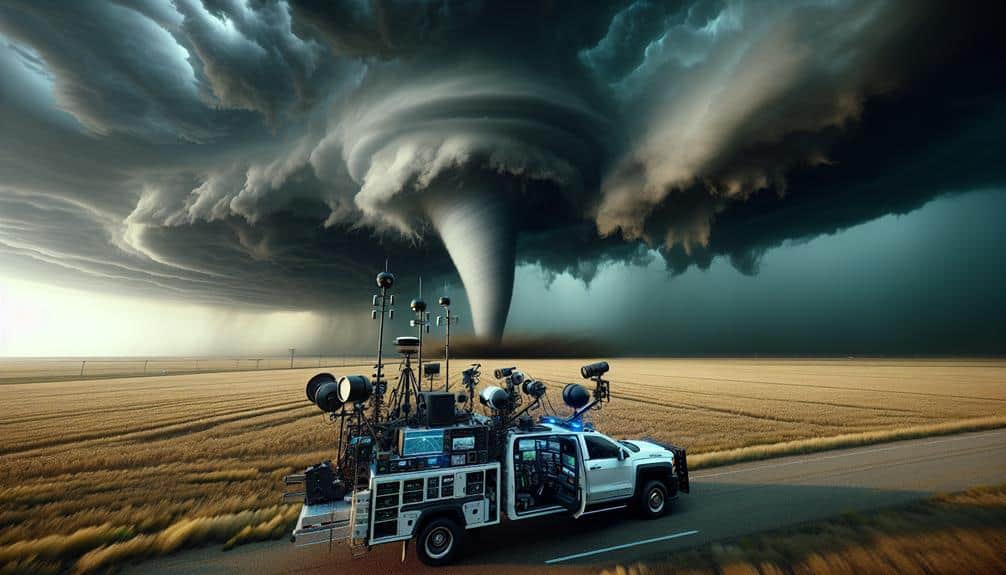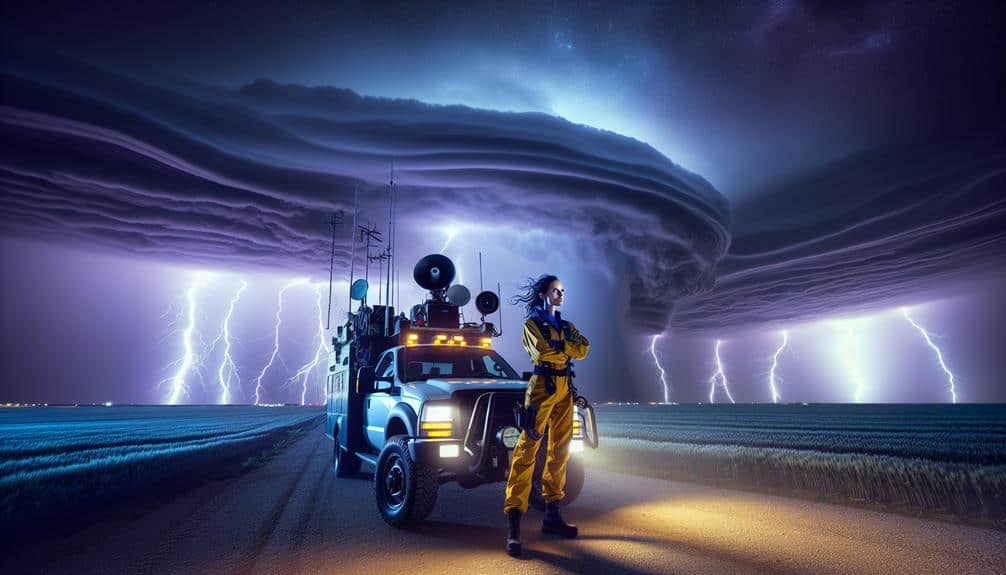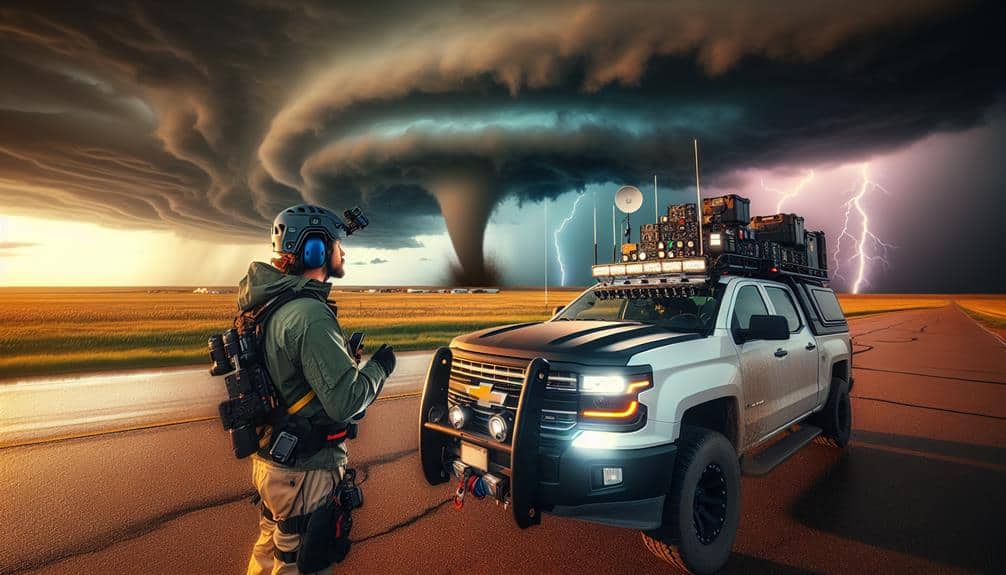When storm chasing in Tornado Alley, we need gear that guarantees accuracy and safety. A high-quality weather radar, utilizing dual-polarization, provides precise storm tracking. Our durable all-terrain vehicle, with robust suspension, tackles rough landscapes. Waterproof camera gear protects essential equipment, while a mobile internet hotspot offers real-time data access. GPS navigation systems keep us on course, and portable power supplies ensure uninterrupted operations. Sturdy tripods stabilize our cameras in high winds. Protective clothing and two-way radio communication keep us safe and connected. For a deeper plunge into each piece of gear and its scientific merits, explore further.
Key Points
- High-quality weather radar provides accurate storm tracking and tornado path prediction.
- Durable all-terrain vehicle ensures safe navigation through rough terrains.
- Waterproof camera gear protects equipment from harsh weather conditions.
- Mobile internet hotspot offers real-time weather data and communication.
High-Quality Weather Radar
A high-quality weather radar is necessary for accurately tracking storm formations and predicting tornado paths in real-time. As storm chasers, we rely on radar accuracy to provide precise data on storm intensity, speed, and direction. This technology enables us to make informed decisions, ensuring both safety and effectiveness in our pursuit of tornadoes.
Advancements in radar technology have greatly enhanced our capabilities. Modern radars now offer dual-polarization, which allows us to distinguish between different types of precipitation and better identify tornado signatures. These improvements in radar accuracy are crucial for precise storm tracking. Additionally, phased array radar systems provide faster updates, giving us near real-time data to react swiftly to changing storm conditions.
Data visualization plays an important role in interpreting radar information. Advanced software platforms transform raw data into detailed visual formats, such as velocity maps and reflectivity scans. These visual tools help us quickly assess the storm's structure and intensity, making it easier to predict potential tornado development.
Durable All-Terrain Vehicle
When venturing into the unpredictable terrain of Tornado Alley, we rely on a durable all-terrain vehicle (ATV) to navigate rough roads and challenging environments efficiently. Our ATV's off-road capabilities are essential for traversing muddy fields, rocky paths, and flooded areas.
Here are some key features we look for in our vehicle:
- Robust Suspension System: A high-quality suspension system ensures smooth navigation over uneven terrains and absorbs shocks from unexpected obstacles.
- High Ground Clearance: With raised ground clearance, our ATV can easily pass over debris and avoid getting stuck in deep mud or water.
- All-Terrain Tires: Specialized tires provide excellent traction on diverse surfaces, from wet grass to loose gravel, enhancing maneuverability and stability.
- Powerful Engine: A reliable engine with superior torque ensures we've the power needed to tackle steep inclines and rough landscapes.
Regular vehicle maintenance is non-negotiable; we perform routine checks on the engine, suspension, and tires to guarantee peak performance. Safety precautions, such as installing roll cages and harnesses, are vital to minimize risks.
Additionally, our ATV is equipped with emergency response gear, including first aid kits and communication devices, to handle unforeseen situations efficiently. This combination of features ensures our readiness and safety while storm chasing.
Waterproof Camera Gear
When we're out in Tornado Alley, our camera gear needs to withstand extreme weather conditions. We prioritize durable camera protection with robust lens and sensor shields to maintain image quality.
Additionally, we use weatherproof carrying cases to safeguard our equipment stays dry and functional.
Durable Camera Protection
Reliable waterproof camera gear is essential for storm chasers to guarantee their equipment remains functional and secure in extreme weather conditions. To thrive in Tornado Alley, we need gear that offers extreme protection for our camera lenses and bodies. Ensuring that our weatherproof gear is up to the task isn't just a preference—it's essential for storm chasing.
Here's what we consider indispensable for durable camera protection:
- Waterproof Camera Housing: A robust housing unit shields our cameras from torrential rain and debris, ensuring the internal electronics remain dry and operational.
- Weather-Sealed Camera Bodies: Cameras with built-in weather sealing provide a fundamental layer of protection against moisture infiltration, reducing the risk of damage to sensitive components.
- Lens Hoods and UV Filters: These attachments protect the camera lens from direct rain impact and potential scratches, preserving image clarity and extending the lens' lifespan.
- Dry Bags: In extreme weather, dry bags offer an additional safeguard, ensuring that our gear remains dry when not in use, effectively preventing moisture buildup.
Using precise, data-driven decisions, we can mitigate risks and focus on capturing the awe-inspiring power of nature. Our freedom to chase storms relies on the reliability of our gear, reinforcing the need for uncompromised durability.
Lens and Sensor Shields
Protecting our camera lenses and sensors from harsh weather elements demands specialized shields that maintain functionality without compromising image quality. For storm chasing, it's essential we use waterproof lens covers that guard against rain, dust, and debris. High-quality optical glass or polycarbonate materials guarantee these shields don't degrade image clarity. Advanced hydrophobic coatings on these shields facilitate easy lens cleaning, allowing us to quickly wipe away water droplets without streaking.
Sensor maintenance in extreme conditions requires robust solutions. We need weather-sealed camera bodies and additional sensor shields to prevent moisture and particles from infiltrating the camera internals. This is especially important when capturing high-speed tornadoes where debris is a constant threat. Regularly utilizing sensor cleaning kits, which often include anti-static brushes and air blowers, maintains the sensor free from contaminants that could compromise image fidelity.
In our quest for capturing the perfect storm, using gear designed to withstand adverse conditions is non-negotiable. By integrating waterproof lens and sensor shields into our setup, we maintain our cameras' operational integrity and image precision, enabling us to focus on the exhilarating freedom of storm chasing without technical hindrances.
Weatherproof Carrying Cases
Safeguarding our gear remains safe and functional in harsh environments, sturdy weatherproof carrying cases are essential for waterproof camera protection during storm chasing. When we're out in Tornado Alley, our equipment is constantly exposed to extreme weather conditions. Using weatherproof cases guarantees our gear remains operational and secure.
When selecting the right carrying case, we should focus on a few critical features:
- Impact resistant and shockproof design: Our cases need to withstand drops and jolts, guaranteeing our sensitive camera equipment remains intact.
- Waterproof seals: These prevent moisture from seeping in, shielding our cameras from rain, mud, and even accidental submersion.
- Secure, lockable latches: To keep our gear safe from unauthorized access and make certain that the case remains closed during turbulent conditions.
- Durable material construction: High-quality polymers like polycarbonate offer superior protection without adding excessive weight.
Choosing cases that meet these criteria gives us the freedom to focus on capturing the perfect storm footage without worrying about our gear.
Sturdy weatherproof carrying cases can make the difference between a successful storm chase and expensive equipment damage. By investing in quality, we guarantee our tools are always ready for the next big chase.
Mobile Internet Hotspot
A mobile internet hotspot is vital for accessing real-time weather data and communication channels while storm chasing in remote areas of Tornado Alley. We need a robust device that guarantees data security, so our sensitive information is protected. With high-speed connectivity, we can stay ahead of rapidly developing weather conditions. Battery life is essential; our hotspot should last through extended chases without frequent recharges, giving us the freedom to stay mobile and responsive.
When selecting a mobile hotspot, coverage area and signal strength are paramount. Tornado Alley often has spotty coverage, so we need a device that excels in maintaining a strong connection even in rural settings. This reliability allows us to communicate with fellow chasers and receive timely updates from meteorological sources. Using a hotspot with superior antennas and multi-band support can greatly enhance our connectivity, reducing the chances of signal drops.
Moreover, we should look for a device that offers customizable data plans to match our usage needs. This flexibility guarantees that we've ample data without unnecessary costs. In the unpredictable environment of Tornado Alley, having a reliable mobile internet hotspot isn't just a convenience; it's a necessity for effective storm chasing.
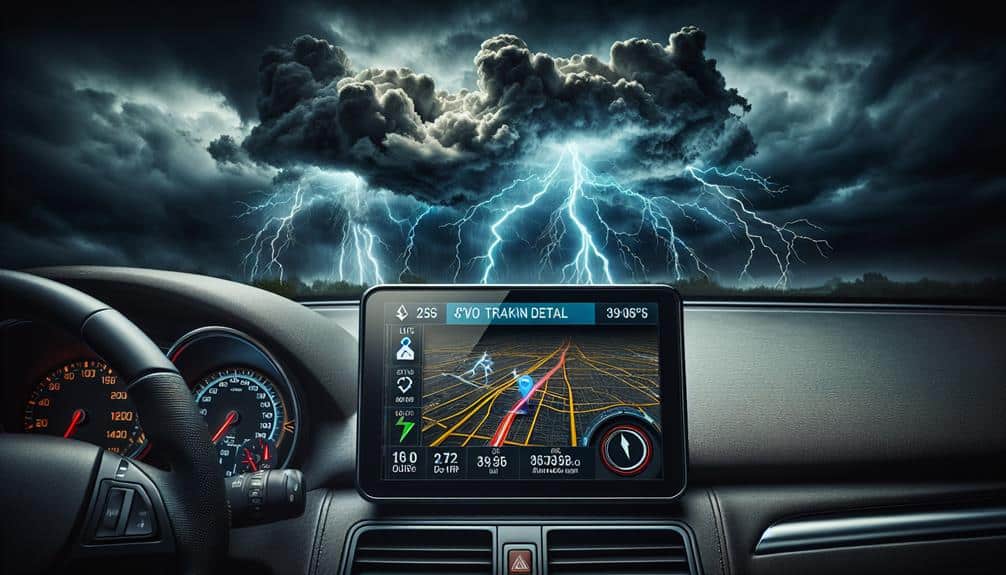
With precise geolocation and real-time updates, a GPS navigation system is essential for tracking storm paths and traversing the challenging terrains of Tornado Alley. Our GPS device needs exceptional GPS accuracy to guarantee we're on the right track, especially when visibility is compromised by severe weather conditions. Equally important is the battery life; the last thing we need is our navigation system dying in the middle of an intense chase.
Having offline maps is a game changer. When cell signals become unreliable, offline maps allow us to stay informed and on course. Real-time updates are crucial for adapting to rapidly changing weather patterns.
To illustrate, let's break down the key features:
- High GPS Accuracy: Enables precise location tracking, essential for dodging hazardous areas.
- Extended Battery Life: Ensures the device remains functional throughout prolonged chases.
- Offline Maps: Provides continuous navigation even in areas with poor connectivity.
- Real-Time Updates: Keeps us informed of new storm data, enabling quick route adjustments.
Choosing a robust GPS navigation system with these features not only enhances our safety but also allows us to focus on the exhilaration of the chase, ensuring we're always a step ahead of the storm.
Emergency Medical Kit
When storm chasing, it's important that we carry an emergency medical kit equipped with essential medical supplies. The kit should be compact and portable, ensuring we can administer first aid without delay in important situations.
Prioritizing items like antiseptics, bandages, and pain relievers can greatly impact our safety and response efficiency.
Essential Medical Supplies
Packing a well-stocked emergency medical kit is vital for storm chasers to address potential injuries or health issues encountered in the field. We must be prepared to handle a range of medical emergencies, from minor cuts to more severe traumas. Our first aid kit should include items specifically chosen for the unpredictable and often hazardous conditions we face.
Here's a breakdown of the essential components:
- Trauma Supplies: Include sterile gauze, adhesive bandages, antiseptic wipes, and a tourniquet. These items help manage bleeding, disinfect wounds, and stabilize injuries until professional medical help arrives.
- Medications: Stock up on over-the-counter pain relievers, antihistamines, and anti-inflammatory drugs. Additionally, include any personal prescription medications that may be required during an emergency response.
- Tools and Equipment: A digital thermometer, tweezers, medical scissors, and a CPR mask are indispensable for accurate diagnosis and effective treatment of various conditions.
- Hydration and Nutrition: Pack electrolyte tablets, energy bars, and a compact water purification system. These supplies are vital for maintaining our physical stamina and cognitive function during extended storm-chasing missions.
Compact and Portable
A compact and portable emergency medical kit guarantees that, despite the limited space in our storm-chasing vehicles, we carry all necessary supplies to address medical emergencies effectively and efficiently. This is important when navigating Tornado Alley, where quick access to medical care can be miles away. By utilizing lightweight equipment and easy setup configurations, we make sure that our medical response isn't compromised by the constraints of our mobile environment.
In our kits, compact gear with reliable performance is paramount. Items such as tourniquets, antiseptic wipes, and trauma shears are chosen for their ability to deliver critical care without occupying excessive space. We also include a variety of bandages, gauze pads, and adhesive tapes, all of which are selected based on their compact form and ease of use.
To further enhance our preparedness, we incorporate tools like portable blood pressure monitors and pulse oximeters. These devices are lightweight and offer easy setup, allowing us to quickly assess essential signs in emergency situations. Additionally, emergency blankets and instant cold packs are included for their dual functionality and minimal storage requirements.
Portable Power Supply
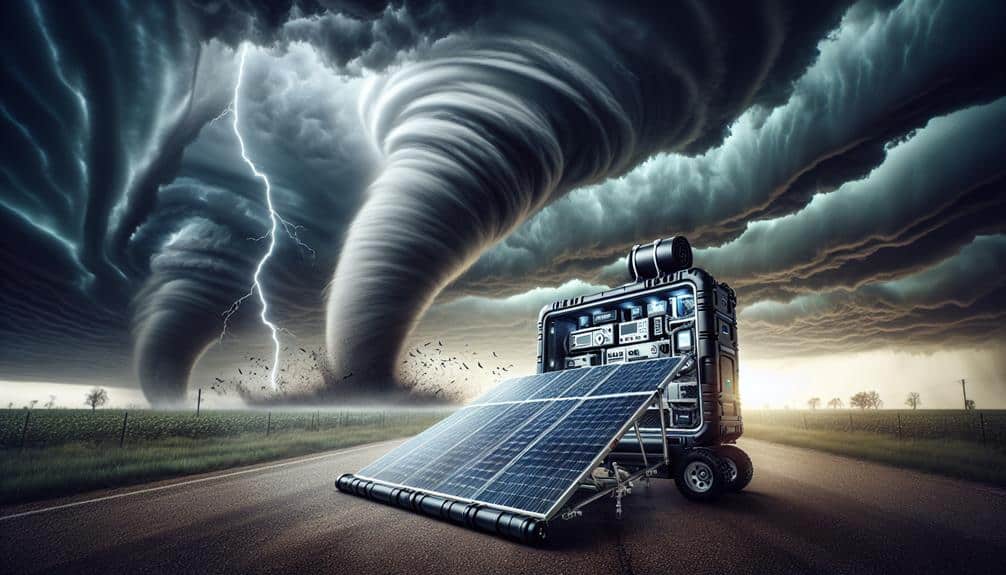
To guarantee our electronic devices remain operational throughout a storm chase, we rely on a high-capacity, portable power supply equipped with multiple output ports and fast-charging capabilities. This secures that our GPS, cameras, and communication devices remain active, essential for capturing data and staying safe.
Incorporating solar panels and power banks in our gear is necessary. Solar panels allow us to harness renewable energy, perfect for prolonged chases. Pairing these with high-capacity power banks means we're never caught off guard by a drained battery.
We rely on these features in a portable power supply:
- High-capacity Battery: A minimum of 20,000 mAh to sustain our devices for extended periods.
- Multiple Output Ports: At least two USB-C and two USB-A ports to charge multiple devices simultaneously.
- Solar Charging Capability: Integrated or compatible solar panels for continuous power.
- Fast-Charging Technology: Ensures rapid recharging of devices, crucial during short breaks.
Maintaining reliable power is essential for receiving emergency alerts and ensuring seamless communication. Without these, we risk missing critical weather updates and losing contact with our team. This power setup grants us the freedom to chase storms confidently, knowing our devices are always ready.
Sturdy Tripod
When storm chasing, our tripod must provide stability in high winds, ensuring accurate data collection without camera shake.
We need quick setup features to adapt rapidly to changing conditions.
Additionally, the tripod's build materials must be robust enough to withstand harsh environmental stressors.
Stability in High Winds
Given the extreme conditions of tornado alley, maintaining the stability of our equipment with a robust tripod is crucial for capturing high-quality data and imagery. A wind-resistant tripod paired with a stable camera mount is essential to withstand the high-velocity winds we encounter. To secure our setup remains intact, we must prioritize both the tripod's integrity and how it interacts with our other gear.
- Sturdy tripod: A durable, wind-resistant tripod crafted from premium materials like carbon fiber is necessary. This minimizes vibrations and sway, even in gusty conditions.
- Steady camera mount: The tripod should feature a stable camera mount with reliable locking mechanisms. This ensures our cameras remain stable and aligned, preventing blurred images and lost data.
- Reliable vehicle anchoring: When setting up near our vehicle, we must employ dependable vehicle anchoring techniques. Heavy-duty anchor points and sandbags can prevent the tripod from being displaced by wind.
- Robust equipment straps: Using robust equipment straps to tether the tripod to solid objects or the vehicle adds an additional layer of security. These straps should be constructed from sturdy, weather-resistant materials to withstand the harsh environment.
Quick Setup Features
While ensuring stability in high winds is essential, having a sturdy tripod with quick setup features can greatly enhance our efficiency in rapidly changing weather conditions. In the dynamic world of storm tracking, every second counts.
A tripod with rapid deployment capabilities allows us to swiftly position our equipment, minimizing setup time and maximizing observation and data collection.
Advanced tripods with quick-lock mechanisms and adjustable legs provide the flexibility needed to adapt to uneven terrain, a common scenario in Tornado Alley. These features are vital when we need to set up under time constraints, ensuring our gear remains stable even in gusty conditions. Additionally, tripods with integrated spirit levels and leg angle selectors contribute to precise, hassle-free setups.
Safety precautions are equally important. A quick setup tripod helps us avoid prolonged exposure to hazardous weather, enhancing our safety margins. The ability to quickly dismantle and move the equipment can be a lifesaver during sudden shifts in storm patterns.
Ultimately, combining rapid deployment with robust stability empowers us to focus on capturing critical data and imagery, giving us the freedom to chase storms effectively while prioritizing our safety.
Durable Build Materials
Choosing a tripod made from robust materials like carbon fiber or aluminum alloy guarantees prolonged performance and resilience under the challenging conditions of Tornado Alley. It's crucial that material strength and weather resistance are top priorities when selecting a tripod for storm chasing.
Carbon fiber tripods offer exceptional strength-to-weight ratios, ensuring that our gear stays stable without adding unnecessary weight.
Conversely, aluminum alloy tripods provide outstanding impact resistance and durability.
When we're in the field, we require gear that can withstand high winds, heavy rain, and sudden impacts. The appropriate tripod provides:
- Material Strength: Carbon fiber and aluminum alloy offer unmatched tensile strength, ensuring our equipment remains steady.
- Weather Resistance: These materials can withstand corrosion and degradation from exposure to the elements, ensuring longevity.
- Impact Resistance: Both materials have the ability to absorb and dissipate sudden impacts, safeguarding our camera gear.
- Longevity: With high-quality construction materials, our tripod will withstand numerous storm chases, delivering dependable service for years.
Protective Clothing
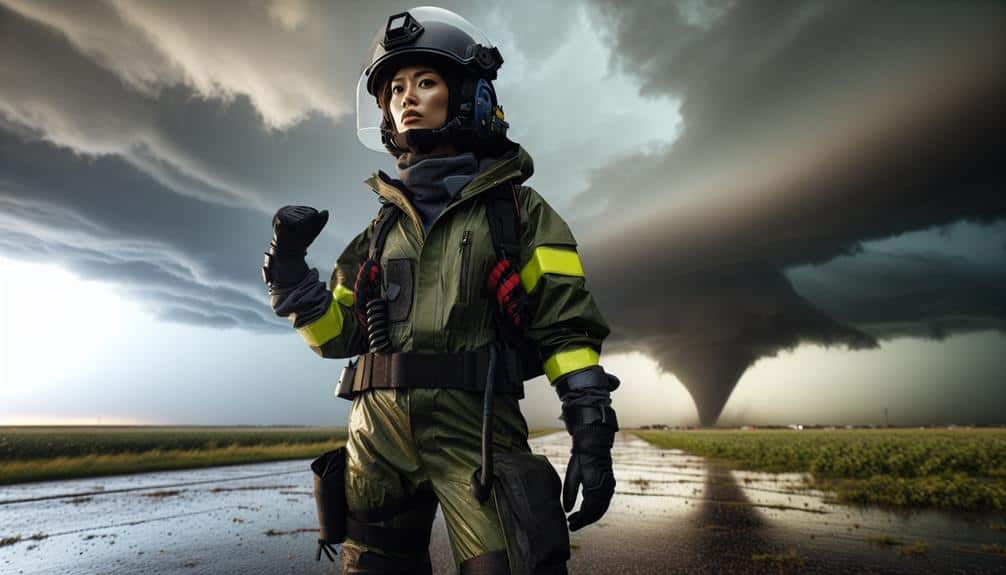
Wearing protective clothing is essential for storm chasers to mitigate the risks of extreme weather conditions and debris. Our gear must be equipped to handle various meteorological phenomena, ensuring both safety and mobility. Protective goggles are non-negotiable to shield our eyes from flying debris and intense wind gusts. High-impact polycarbonate lenses provide optimal clarity and durability, vital for navigating the unpredictable elements of Tornado Alley.
Breathable fabric is crucial in our clothing to regulate body temperature and moisture. Technical fabrics like Gore-Tex offer excellent breathability while remaining waterproof, making them ideal for the variable conditions we face. Breathable layers also allow us to maintain comfort without sacrificing protection, particularly in high-humidity environments.
Wind resistant gloves are another vital component of our gear. These gloves are designed to provide dexterity and a secure grip while shielding our hands from the cold and abrasive winds. Materials like Kevlar offer both durability and flexibility, ensuring our hands remain functional under stress.
Two-Way Radio Communication
In addition to protective clothing, reliable two-way radio communication is paramount for coordinating movements and guaranteeing team safety during storm chasing expeditions. We're often in remote locations where cellular networks are unreliable, so robust radios are our lifeline. High-quality radios with strong signal strength and appropriate radio frequency bands are essential.
When selecting two-way radios, consider the following factors:
- Radio Frequency: Choose radios that operate on UHF and VHF frequencies. UHF performs well indoors and in urban areas, while VHF is better for open, rural environments.
- Signal Strength: Opt for radios with high wattage to guarantee superior signal strength, especially in adverse weather conditions.
- Communication Range: Guarantee the radios provide an extensive communication range. A minimum of 10-15 miles is ideal for maintaining contact over sprawling terrains.
- Interference Resistance: Select models with advanced interference resistance to avoid disruptions from atmospheric noise and other electronic devices.
Frequently Asked Questions
What Safety Precautions Should I Take While Storm Chasing?
While storm chasing, we should always wear safety gear and establish an emergency plan. Utilize reliable weather forecasting tools, maintain communication devices, and make sure our vehicle is equipped for adverse conditions. Safety first, adventure second.
Are There Specific Apps Recommended for Tracking Storms in Real-Time?
For those of us chasing nature's fury, top-rated apps like RadarScope and Storm Radar provide real-time alerts and precise data. These apps let us stay ahead of the curve, ensuring we make informed decisions on the move.
How Do I Find Local Storm Chaser Communities or Groups?
To find local storm chaser communities, we can explore online meetups and forums for enthusiasts. Networking at meteorological events and participating in specialized scientific seminars enhance our connections and knowledge-sharing opportunities, empowering us with greater freedom and expertise.
What Are the Best Practices for Photographing Storms Safely?
We embrace the power of nature through our lenses. For safe storm photography, optimize camera settings, maintain sturdy equipment, and focus on strategic positioning and composition. Balancing exposure and focal length enhances visual impact while preserving our freedom.
How Do I Secure Sponsorships or Funding for Storm Chasing Activities?
We'll secure sponsorships by employing sponsorship strategies like marketing partnerships and brand collaborations. Additionally, crowdfunding leverages community support. Accurate data on storm frequency and safety measures enhances our credibility, attracting sponsors who value scientific integrity and adventurous spirit.
